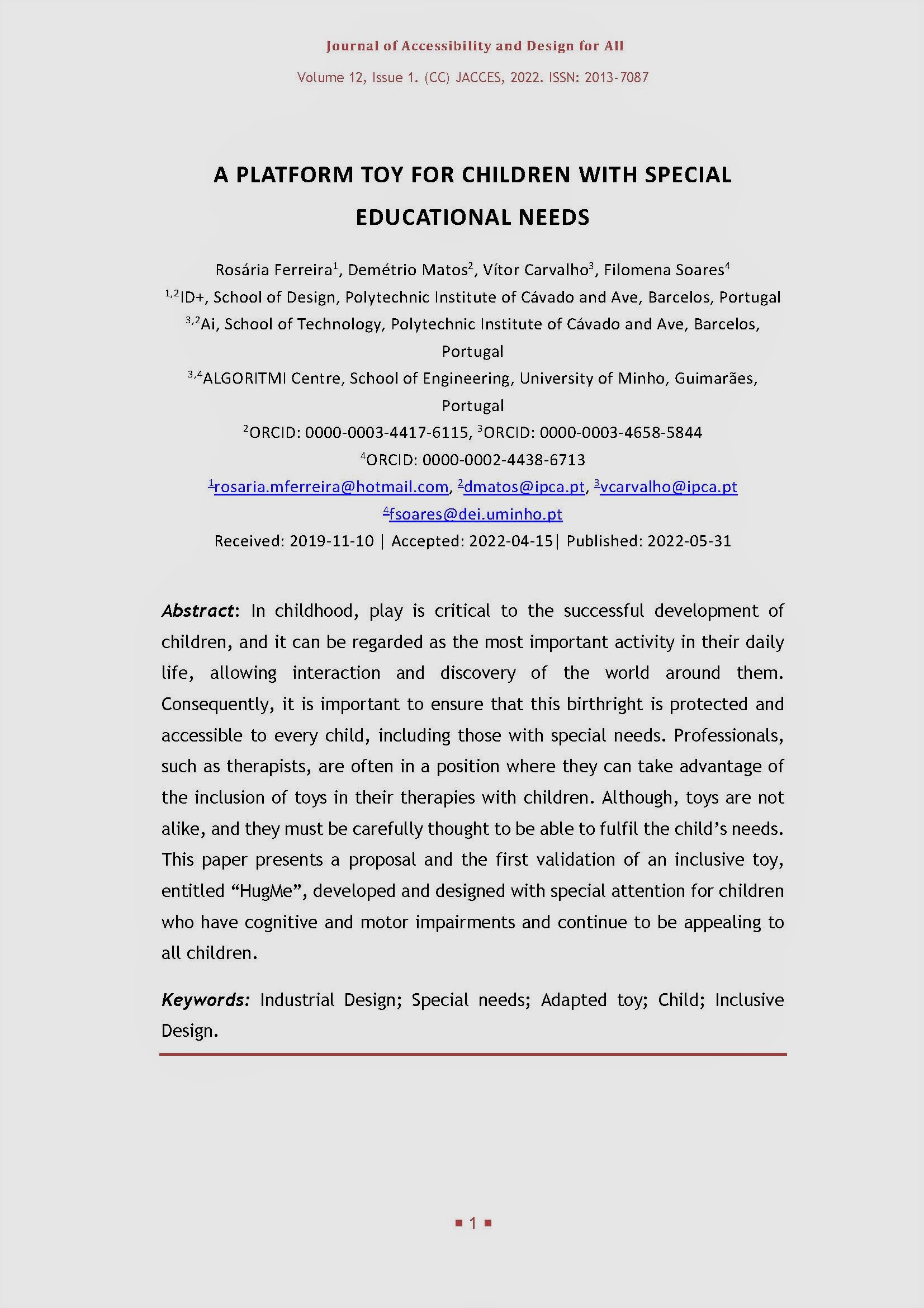A platform toy for children with special educational needs
DOI:
https://doi.org/10.17411/jacces.v12i1.250Abstract
In childhood, play is critical to the successful development of children, and it can be regarded as the most important activity in their daily life, allowing interaction and discovery of the world around them. Consequently, it is important to ensure that this birthright is protected and accessible to every child, including those with special needs. Professionals, such as therapists, are often in a position where they can take advantage of the inclusion of toys in their therapies with children. Although, toys are not alike, and they must be carefully thought to be able to fulfil the child’s needs. This paper presents a proposal and the first validation of an inclusive toy, entitled “HugMe”, developed and designed with special attention for children who have cognitive and motor impairments and continue to be appealing to all children.References
Abreu, A., Arezes, P., Silva, C., & Santos, R. (2015). A case study of product usability of a pelvic device used by children with neuromotor impairments. Procedia Manufacturing, 3(AHFE), 5451–5458. https://doi.org/10.1016/j.promfg.2015.07.677
Azatyan, T., & Asoyan, L. (2017). PLAY ASSESSMENT OF CHILDREN WITH SPECIAL NEEDS. Armenian Journal of Special Education, Vol. 5 No1(Main Issues in Special Education), 252–256.
Barron, C., Beckett, A., Coussens, M., Desoete, A., Jones, N. C., Lynch, H., … Salkeld, D. F. (2017). Barriers to Play and Recreation for Children and Young People with Disabilities Exploring Environmental Factors. (Sciendo, Ed.). De Gruyter Open Poland. https://doi.org/https://doi.org/10.1515/9783110526042
Besio, S., Bulgarelli, D., Iacono, I., Jansens, R., Mizzi, M., & Perino, O. (2018). BECOMING EXPERT IN PLAYING WITH CHILDREN WITH DISABILTIIES. THE LUDI TRAINING SCHOOL “PLAY AND TOYS FOR ALL.” Today´s Children Tomorrow´s Parents, No. 47-48(Play and Children with disabilities. Interdisciplinary Perpectives.), 62–73.
Brodin, J. (1999). Play in Children with Severe Multiple Disabilities: Play with toys - a review. International Journal of Disability, Development and Education, 46(January 2015), 25–34. https://doi.org/10.1080/103491299100704
Brougère, G. (2004). Brinquedos e companhia. (Cortez, Ed.). São Paulo.
Directiva 2009/48/CE. DIRECTIVA 2009/48/CE do Parlamento Europeu e do conselho de 18 de Junho de 2009 relativa à segurança dos brinquedos., Jornal Oficial da União Europeia § (2009).
Dreyfuss, H., Tilley, A., & Wilcox, S. (2002). The Measure of Man and Woman: Human Factors in Design, Revised Edition. (J. W. & Sons, Ed.) (revised ed). New York.
Ferreira, R., Matos, D., Soares, F., & Carvalho, V. (2017). “HugMe” – Validation of a prototype of an inclusive toy for children. In International Symposium on Occupational Safety and Hygiene. Guimarães.
Ginsburg, K. R. (2007). The Importance of Play in Promoting Healthy Child Development and Maintaining Strong Parent-Child Bond : Focus on Children in Poverty abstract. Pediatrics, 119(1), 182–188. https://doi.org/10.1542/peds.2011-2953
Heide, J., Fock, J., Otten, B., & Stremmelaar, E. (2005). Kinematic Characteristics of Postural Control during Reaching in Preterm Children with Cerebral Palsy, 58(3), 586–593. https://doi.org/10.1203/01.pdr.0000176834.47305.26
Hsieh, H. C. (2008). Effects of ordinary and adaptive toys on pre-school children with developmental disabilities. Research in Developmental Disabilities, 29(5), 459–466. https://doi.org/10.1016/j.ridd.2007.08.004
Isabelle, S., Bessey, S., Dragas, K., Blease, P., Shepherd, J., & Lane, S. (2003). Assistive Technology for Children with Disabilities. Occupational Therapy In Health Care, 16(4), 29–51. https://doi.org/10.1080/J003v16n04_03
Karagozler, M., Poupyrev, I., Fedder, G., & Suzuki, Y. (2013). Paper generators: harvesting energy from touching, rubbing and sliding. The 26th Annual ACM Symposium, 23–30. https://doi.org/10.1145/2501988.2502054
Lane, S., & Mistrett, S. (1996). Play and assistive technology issues for infants and young children with disabilities: A preliminary examination. Focus on Autism and Other Developmental Disabilities, 11(2), 96–104. https://doi.org/10.1177/108835769601100205
Martinez, J. E. (2007). Observação do desempenho motor da criança com deficiência física por intermédio da brincadeira: um estudo de caso. Londrina.
Missiuna, C., & Pollock, N. (1991). Play Deprivation in Children With Physical Disabilities: The Role of the Occupational Therapist in Preventing Secondary Disability. The American Journal of Occupational Therapy, 45(C), 882–888.
Queiroz, N., Maciel, D., & Branco, A. (2006). Brincadeira e desenvolvimento infantil: um olhar sociocultural construtivista. Paidéia (Ribeirão Preto), 16(34), 169–179. https://doi.org/10.1590/S0103-863X2006000200005
Ruffino, A., Mistrett, G., Tomita, M., Poonam, H., & Mistrett, S. (2006). The Universal Design for Play Tool : Establishing Validity and Reliability. Journal of Special Education Technology, 21(4), 25–38.
Saptari, A., Kiat Ng, P., & Mukyi, M. (2013). The importance of child anthropometry in child product Designs. Anthropometric Research in Malaysia, 125–145. https://doi.org/10.13140/2.1.4006.2726
UNICEF. (1999). Human rights for children and women: How UNICEF helps make them a reality.
Vygotsky, L. (2000). A formação social da mente: o desenvolvimento dos processos psicológicos superiores. (M. Fontes, Ed.) (6a ed.). São Paulo.

Downloads
Published
How to Cite
Issue
Section
License
Copyright (c) 2022 Rosária Ferreira, Demétrio Matos, Vítor Carvalho, Filomena Soares

This work is licensed under a Creative Commons Attribution-NonCommercial 4.0 International License.
- Authors retain copyright and grant the journal right of first publication with the work simultaneously licensed under a Creative Commons Attribution License that allows others to share or adapt the work with an acknowledgment of the work's authorship and initial publication in this journal. Use of the work for commercial purposes are not allowed.
- Authors are able to publish the journal's published version of the work in other media (e.g., post it to an institutional repository or publish it in a book), as far as they inform the Journal of Accessibility and Design for All of that fact. When publishing their work in other sources, authors must mention the name of the Journal of Accessibility and Design for All, its ISSN, the number and issue in which the article was published and a link to the main page of the Journal of Accessibility and Design for All. Optionally, they can also include a link to the article published in the Journal of Accessibility and Design for All.
- Authors are permitted and encouraged to post their work online (e.g., in institutional repositories or on their website), as it can lead to productive exchanges, as well as earlier and greater citation of published work.



